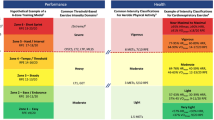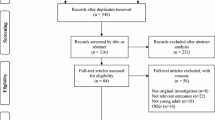Abstract
This paper studies the relationship between EMG and ECG parameters during intensified stepdosed physical exercises with the use of a bicycle ergometer in subjects doing regular exercises and sports. The dynamics of changes in EMG and ECG parameters is observed in subjects during a step-dosed intensification of exercises. Specifically, if physical activity is not intense, muscular effort is mainly due to an increase in the heart rate; if it is highly intense, the electrophysiological processes of the whole myocardium are involved. The interrelation of the parameters of the muscular and cardiovascular systems is shown to increase with the intensity of physical activity.
Similar content being viewed by others
References
Anokhin, P.K., Ocherki po fiziologii funktsional’nykh sistem (Essays on Physiology of Functional Systems), Moscow: Meditsina, 1975.
Priimakov, A.A., Activity and interconnections of muscular and cardiovascular systems in different states during muscular activity in athletes, Fizich. Vosp. Stud., 2012, no. 6, p. 94.
Karpman, V.L., Belotserkovskii, Z.B., and Gudkov, I.A., Testirovanie v sportivnoi meditsine (Testing in Sporting Medicine), Moscow: Fizkul’tura i Sport, 1988.
Dembo, A.G., Vrachebnyi kontrol' v sporte (Medical Supervision in Sport), Moscow: Meditsina, 1988.
Zhuravleva, A.I. and Graevskaya, N.D., Sportivnaya meditsina i lechebnaya fizkul’tura: Rukovodstvo (Sporting Medicine and Therapeutic Exercises: A Guide), Moscow: Meditsina, 1993.
Sutula, V.D., Alabin, V.G., Khokhlov, G.G., and Nesterenko, A.Yu., Heart rate in athletes during different physical activities, Teor. Prakt. Fiz. Kul’t., 1996, no. 1, p. 40.
Tarasova, O.S., Borovik, A.S., Kuznetsov, S.Yu., et al., The pattern of changes in physiological parameters in the course of changes in physical exercise intensity, Hum. Physiol., 2013, vol. 39, no. 2 p. 171.
Skladanivskaya, I.V. and Maidanyuk, O.V., Using the method of surface electromyography for determining the anaerobic threshold in skilled athletes specialized in boar-racing, in Metody otsenki i povysheniya rabotosposobnosti u athletesov (Methods for Estimating and Increasing Working Capacity in Athletes) (Proc. AllRussian Scientific Practical Conference with International Participation), St. Petersburg, 2013, p. 96.
Fiziologicheskie osnovy fizicheskogo vospitaniya (Physiological Bases of Physical Training), St. Petersburg, 2012, p. 35.
Zemtsova, I.I., Sportivnaya fiziologiya. Uchebnoe posobie dlya VUZov (Sporting Physiology. A University Manual), Kiev: Olimpiiskaya Literatura, 2010.
Analizator elektroneiromiograficheskii “Sinapsis”. Standartnaya konfiguratsiya. Pasport (A Sinapsis Electroneuromyographic Analyzer: Standard Configuration and Certificate), NMFT, 2011, 941315.001PS.
Komantsev, V.N., Metodicheskie osnovy klinicheskoi elektroneiromiografii (Methodical Bases of Clinical Electroneuromyography), St. Petersburg, 2001.
Karpman, V.L., Dinamika krovoobrashcheniya u athletesov (Blood Circulation Dynamics in Athletes), Moscow: Fizicheskaya Kul’tura i Sport, 1982.
Platonov, A.E., Statisticheskii analiz v meditsine i biologii: zadachi, terminologiya, logika, komp’yuternye metody (Statistical Analysis in Medicine and Biology: Tasks, Terminology, Logics, and Computer Methods), Moscow: RAMN, 2000.
Mokhan, R., Biokhimiya myshechnoi deyatel’nosti i fizicheskoi trenirovki (Biochemistry of Muscular Activity and Physical Training), Kiev: Olimpiiskaya Literatura, 2001.
Seluyanov, V.N., Myakinchenko, E.B., Kholodnyak, D.B., and Obukhov, S.M., Physiological Mechanisms and Methods for Determining the Aerobic and Anaerobic Thresholds, Teor. Prakt. Fiz. Kul’t., 1991, no. 10, p. 10.
Conconi, F., Ferrari, M., Ziglio, P.G., et al., Determination of the anaerobic threshold by a noninvasive field test in runners, J. Appl. Physiol., 1982, vol. 52, p. 869.
Seluyanov, V.N., Determination of cardiac output during graded testing, in Yubileinyi sbornik trudov uchenykh RGAFK, posvyashchennyi 80-letiyu Akademii (A Jubilee Collection of Works by Scientists of the Russian State Academy of Physical Training Devoted to the 80th Anniversary of the Academy), Moscow: Fizkul’tura, Obrazovanie i Nauka, 1997, vol. 1, p. 164.
Rukovodstvo po kardiologii. Prakticheskoe posobie (Guide in Cardiology: A Practical Manual), Kovalenko, V.N., Ed., Kiev: Morion, 2008.
Landyr’, A.P., Monitoring serdechnoi deyatel’nosti v upravlenii trenirovochnym protsessom v fizicheskoi kul’ture i sporte (Monitoring of Heart Activity in Supervision of the Training Process in Physical Exercises and Sports), Moscow: Triada–X, 2011.
Jarek, Maestu, Electromyographic and neuromuscular fatigue thresholds as concepts of fatigue, J. Strength Condit. Res., 2006, vol. 20, no. 4, p. 824.
Holloszy, J.O., Regulation by exercise of skeletal muscle content of mitochondria and GLUT4, J. Physiol. Pharmacol., 2008, vol. 59, Suppl. 7, p. 5.
Kiz’ko, A.P. and Kiz’ko, E.A., Printsipy razvitiya silovykh i tsiklicheskikh sposobnostei dvigatel’nykh edinits razlichnogo tipa i vida: Uchebnoe posobie (Principles for Development of Power and Cyclic Properties of Motor Units of Different Types and Kinds: A Manual), Novosibirsk: NGTU, 2003.
Schiaffino, S., Fiber typesin skeletal muscle: a personal account, Acta Phhysiol., 2010, vol. 199, p. 451.
Vinogradova, O.L., Popov, D.V., Tarasova, O.S., et al., Ergoreflex: Essence of the phenomenon and mechanisms, Aviakosm. Ekol. Med., 2008, vol. 42, p. 5.
Fudin, N.A., Khadartsev, V.A., and Orlov, V.A., Mediko-biologicheskie tekhnologii v sporte. Monografiya (Medical and Biological Technologies in Sport: A Monograph), Mironov, S.P., Ed., Moscow: Izvestiya, 2011.
Author information
Authors and Affiliations
Corresponding author
Additional information
Original Russian Text © N.A. Fudin, S.Ya. Klassina, S.N. Pigareva, 2015, published in Fiziologiya Cheloveka, 2015, Vol. 41, No. 4, pp. 82–90.
Rights and permissions
About this article
Cite this article
Fudin, N.A., Klassina, S.Y. & Pigareva, S.N. Relationship between the parameters of muscular and cardiovascular systems in graded exercise testing in subjects doing regular exercises and sports. Hum Physiol 41, 412–419 (2015). https://doi.org/10.1134/S0362119715040088
Received:
Published:
Issue Date:
DOI: https://doi.org/10.1134/S0362119715040088




